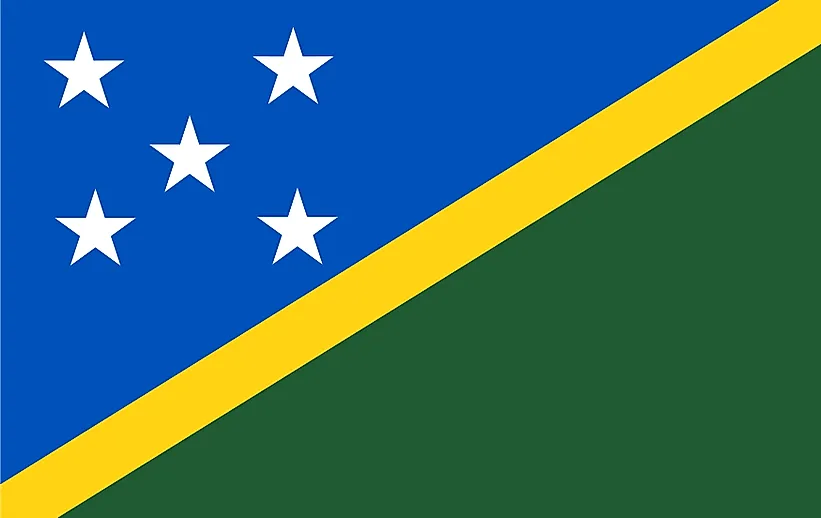
ソロモン諸島
| 大陸 | オセアニア |
| 資本金 | ホニアラ |
| 人口 | 635,027 |
| GDP | $12 億ドル |
| 一人当たりGDP | $2,000 |
| ダイヤルコード | +677 |
| ISOコード(2文字) | SB |
| ISOコード(3文字) | エスエルビー |
ソロモン諸島について
海洋の豊かさと文化の多様性が際立つソロモン諸島へようこそ。28,400平方キロメートルの国土に約1,000の島々、約70万人が暮らすソロモン諸島は、類まれな生物多様性と豊かなメラネシアの遺産を兼ね備えています。
地理的特徴と自然の美しさ
ソロモン諸島の地理は、6つの主要な島と数百の小さな島が二重の鎖状に並んでいる。火山島、サンゴ環礁、そして世界最大の隆起サンゴ環礁であるレンネル島がある。
熱帯雨林、活火山、広大なサンゴ礁などの景観がある。コーラル・トライアングル(珊瑚の三角地帯)に位置するこの国は、世界で最も多様な珊瑚と珊瑚礁の魚種を支える海洋生態系を形成している。
保護地域には、イースト・レネル世界遺産や数多くの海洋保護区がある。同国の自然保護への取り組みは、気候変動の課題に適応しつつ、そのユニークな生物多様性を保全することに重点が置かれている。
文化遺産と伝統
ソロモン諸島の文化は、さまざまな島々にまたがる多様なメラネシアの伝統を表している。ソロモン諸島の遺産には、独特の木彫り、貝殻細工、伝統的な航海術などがある。
伝統芸能には、パンパイプ音楽、独特のダンス、複雑な織物などがある。文化的慣習としては、伝統的な儀式、貝貨交換、慣習的土地所有制度などがある。
郷土料理は根菜類、新鮮な魚介類、トロピカルフルーツが中心だ。地域社会の祝宴や儀式的な食の分かち合いの伝統は、今でも島の生活の中心となっている。
歴史の旅
ソロモン諸島の歴史は、初期のメラネシア人の入植から、ヨーロッパ人との接触、そして独立にまで及ぶ。ソロモン諸島は第二次世界大戦、特にガダルカナルの戦いで重要な役割を果たした。
重要な時代には、初期の太平洋移民、ヨーロッパ人の発見、イギリスの保護国としての地位、第二次世界大戦、1978年の独立が含まれる。第二次世界大戦時の経験は、史跡と不発弾の両方を残している。
現代の経済状況
今日のソロモン諸島の経済は、農業、漁業、林業が中心である。ソロモン諸島は、観光業と持続可能な資源管理に大きな可能性を秘めている。
最近の取り組みでは、持続可能な漁業の実践、エコツーリズムの開発、再生可能エネルギーの導入を重視している。ソロモン諸島の天然資源と戦略的立地は、その開発努力を支えている。
国際関係とグローバルポジション
ソロモン諸島は、気候変動対策を提唱しながら、太平洋地域組織に積極的に参加している。ソロモン諸島の環境問題は、世界的な気候変動に関する議論において、その発言力を広げている。
ご存知でしたか?
- ソロモン諸島は、海洋生物多様性の世界的中心地であるコーラル・トライアングルの一部である。
- この島々は、スペインの探検家アルバロ・デ・メンダーニャによって聖書のソロモン王にちなんで命名された?
- 伝統的な航海術は今でも島間移動に使われているのか?
- この国には70以上の言語がある。
結論
ソロモン諸島は、海洋の豊かさと文化の多様性を併せ持つユニークな島である。サンゴ礁から熱帯雨林まで、伝統的な風習から開発イニシアティブまで、ソロモン諸島は自然と文化の遺産を守りながら進化し続けている。気候変動や持続可能な開発などの課題に取り組む中で、ソロモン諸島は、太平洋の生物多様性の守護者としての地位を維持しつつ、環境保護に力を注いでいる。





